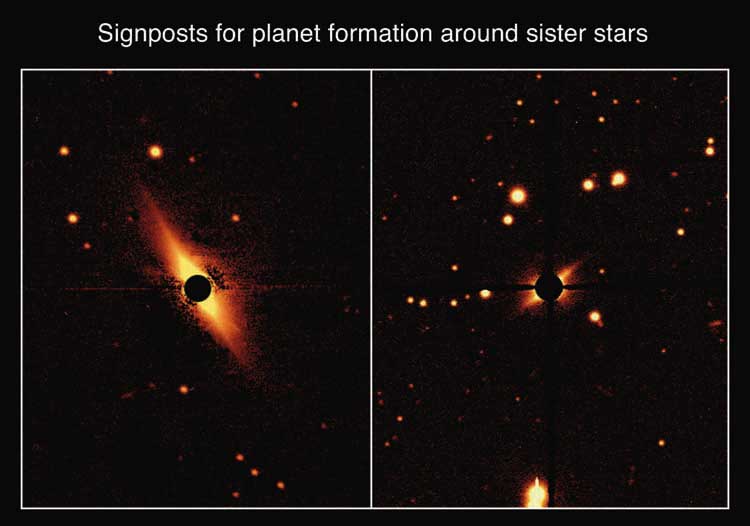
Image Credit:P. Kalas, University of California, Berkeley
Copyright, please do not reproduce without permission from the authors.
AU Mic at 0.8 microns
HD 197481
SAO 56680 HIP 102409
RA (J2000) = 20 45 09.5318
Dec (J2000) = -31 20 27.238
SpT = M1Ve
V = 8.65 mag d = 9.9 pc
Proper Motion (mas/yr) =279.96 -360.61
The disk around AU Microscopii (AU Mic) was first seen in this image obtained
by Paul Kalas on October 15, 2003, from the University of Hawaii 2.2-m
telescope on Mauna Kea, Hawaii.
The image shows a black disk in the center that is suspended
by four thin wires at the focus of the telescope. The black disk produces an
artificial eclipse of AU Mic, just like the Moon occasionally
produces a total eclipse of the Sun. Therefore we do not see
the star AU Mic - it's hidden behind the spot - but we see
the faint nebulosity around it. The nebulosity is produced
by dust grains that orbit the star in a relatively flat disk,
much like the Kuiper Belt of our Solar system. The image was
recorded on a CCD with 2048 x 2048 pixels.
In the image gallery, AU Mic is the closest circumstellar disk
that can be seen in optical reflected light. It is only 10 pc
from the Sun (33 light years). AU Mic's disk is detected in
the image above as close as 50 AU radius from the star, and
as far as 210 AU radius (1 AU = 1 astronomical unit = 93 million miles).
AU Mic is also important because it is beta Pic's sister star.
beta Pic, AU Mic, and approximately 20 other stars appear to move
together in the galaxy and have similar ages. The young stars
comprising the "beta Pic Moving Group" probably formed together
from the same interstellar cloud of gas and dust.
The image above shows beta Pic (left) and AU Mic (right) side-by-side
with the same angular scale and sensitivity. In both images, the black
disk in the center has diameter 10 arcseconds, which corresponponds to
193 AU at beta Pic, and only 99 AU at AU Mic. Remarkably, both disks
appear to have an edge-on orientation when viewed from Earth.
Beta Pic's disk appears
to be much brighter, though. Why? First, beta Pic is a brighter star
and therefore dust around it reflects more light. Second, beta Pic's
disk probably has 3-4 times more dust mass than AU Mic's disk. AU Mic
could be called beta Pic's "little sister".

Basic facts about AU Mic:
1) Stellar Mass = 0.5 Msun, Stellar luminosity = 0.1 Lsun
2) Radius of Disk = 210 AU (21")
3) Radius of central depletion of dust = 17 AU
4) Age = 8-20 Million Year